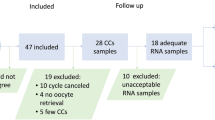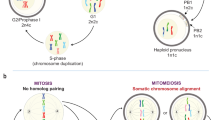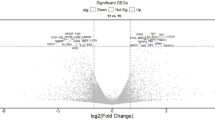Abstract
The hermaphroditic flatworm Dendrocoelum lacteum shows a very pronounced sex difference in chiasma frequency; oocytes have 66 per cent more chiasmata than spermatocytes. The ultrastructural basis of this difference was investigated by three-dimensional reconstruction of synaptonemal complexes from ten oocytes and ten spermatocytes at pachytene and smaller numbers of zygotene nuclei. Oocyte nuclei at pachytene are larger and have longer synaptonemal complexes than the equivalent spermatocyte stage. The difference in synaptonemal complex length (60 per cent) corresponds very closely to the difference in chiasma frequency shown by oocytes and spermatocytes and suggests that synaptonemal complex (SC) length may contribute to the regulation of chiasma frequency. Recombination nodules were observed in both spermatocytes and oocytes but their quantitation was unreliable because they are small and differentiation from the unusually dense and prominent central region is difficult. Analysis of the few zygotene nuclei available shows that pairing is predominantly proterminal in both spermatocytes and oocytes, but oocytes may have several additional interstitial initiations. These extra initiations are likely to be necessary for efficient pairing of the longer oocyte chromosomes.
Similar content being viewed by others
Article PDF
References
Aeppli, E. 1951. Die Chromosomenverhaltnisse bei Dendrocoelum infernale (Steinmann). Ein Beitrage zur Polyploidie in Tierreich. Rev Suisse Zool, 58, 511–518.
Arnold, G. 1909. The prophase in the oogenesis and the spermatogenesis of Planaria lactea O.F.M. (Dendrocoelum lacteum Oerst.). Arch Zellforsch, 3, 431–446.
Ball, I R, and Reynoldson, T B. 1981. British Planarians Synopses of the British Fauna, 19. Edited by D. M. Kermack and R. S. K. Barnes. Cambridge University Press.
Benazzi, M, and Benazzi Lentati, G. 1976. Animal Cytogenetics. Edited by B. John, H. Bauer, S. Brown, H. Kayano, A. Levan, M. White. Vol. 1: Platyhelminthes. Gebruder Borntraeger, Berlin.
Benazzi, M, and Pochini, N. 1959. Alcune osservazioni citologische sulla planaria Dendrocoelum lacteum (O. F. Muller). Boll Zool, 26, 435–444.
Bojko, M. 1985. Human meiosis. IX. Crossing over and chiasma formation in oocytes. Carlsberg Res Commun, 50, 43–72.
Byers, B, and Goetsch, L. 1975. Electron microscopic observations on the meiotic karyotype of diploid and tetraploid Saccharomyces cerevisiae. Proc Natl Acad Sci USA, 72, 5056–5060.
Carpenter, A T C. 1979a. Synaptonemal complex and recombination nodules in wild-type Drosophila melanogaster females. Genetics, 92, 511–541.
Carpenter, A T C. 1979b. Recombination nodules and synaptonemal complex in recombination-defective females of Drosophila melanogaster. Chromosoma, 75, 259–272.
Carpenter, A T C. 1981. EM autoradiographic evidence that DNA synthesis occurs at recombination nodules during meiosis in Drosophila melanogaster females. Chromosoma, 83, 59–80.
Carpenter, A T C. 1984. Recombination nodules and the mechanism of crossing-over in Drosophila. Controlling Events in Meiosis. Society for Experimental Biology Symposium 28. Edited by C. W. Evans and H. G. Dickinson. Company of Biologists Ltd., Cambridge.
Croft, J A, and Jones, G H. 1986. Surface spreading of synaptonemal complexes in locusts. I. Pachytene observations. Chromosoma, 93, 483–488.
Croft, J A, and Jones, G H. 1989. Meiosis in Mesostoma ehrenbergii ehrenbergii. IV. Recombination nodules of spermatocytes; a test of the correspondence of late recombination nodules and chiasmata. Genetics, 121, 255–262.
Dahm, A G. 1961. Cytotaxonomical analyses of four Dendrocoelum species. Lunds Universitets Arsskrift NF Avd 2, 57, 1–44.
Gelei, J. 1913. Uber die Ovogenese von Dendrocoelum lacteum. Arch Zellforsch, 11, 51–150.
Gelei, J. 1921. Die Langskonjugation der Chromosomen. Arch Zellforsch, 16, 52–130.
Gelei, J. 1922. Die Konjugationsfrage der Chromosomen in der Literatur und meine Befunde. Arch Zellforsch, 16, 300–370.
Gillies, C B, Rasmussen, S W, and von Wettstein, D. 1973. The synaptinemal complex in homologous and nonhomologous pairing of chromosomes. Cold Spring Harbor Symp Quant Biol, 38, 117–122.
Holm, P B, Rasmussen, S W, Zickler, D, Lu, B C, and Sage, E. 1981. Chromosome pairing, recombination nodules and chiasma formation in the Basidiomycete Coprinus cinereus. Carlsberg Res Commun, 46, 305–346.
Jones, G H, and Croft, J A. 1986. Surface spreading of synaptonemal complexes in locusts. II. Zygotene pairing behaviour. Chromosoma, 93, 489–495.
Matern, B, and Simak, M. 1968. Statistical problems in karyotype analysis. Hereditas, 59, 280–288.
Matthieson, E. 1904. Ein Beitrag zur Embryologie der Susswasserdendrocoelen. Z wiss Zool, 77, 274–361.
Melander, Y. 1963. Cytogenetic aspects of embryogenesis in Paludiocola, Tricladida. Hereditas, 49, 119–166.
Mogensen, H L. 1977. Ultrastructural analysis of female pachynema and the relationship between synaptonemal complex length and crossing-over in Zea mays. Carlsberg Res Commun, 42, 475–497.
Moses, M J, and Poorman, P A. 1984. Synapsis, synaptic adjustment and DNA synthesis in mouse oocytes. Chromosomes Today 8. Proceedings of the 8th International Chromosome Conference. Edited by M. D. Bennett, A. Gropp and U. Wolf, George Allen and Unwin, London, pp. 90–103.
Oakley, H A. 1982. Meiosis in Mesostoma ehrenbergii ehrenbergii (Turbellaria, Rhabdocoela) II. Synaptonemal complexes, chromosome pairing and disjunction in achiasmate oogenesis. Chromosoma, 87, 133–147.
Oakley, H A, and Jones, G H. 1982. Meiosis in Mesostoma ehrenbergii ehrenbergii (Tubellaria, Rhabdocoela) I. Chromosome pairing, synaptonemal complexes and chiasma localisation in spermatogenesis. Chromosoma, 85, 311–322.
Pastor, J B, and Callan, H G. 1952. Chiasma formation in spermatocytes and oocytes of the Turbellarian Dendrocoelum lacteum. J Genet, 50, 449–454.
Rasmussen, S W, and Holm, P B. 1978. Human meiosis. II. Chromosome pairing and recombination nodules in human spermatocytes. Carlsberg Res Commun, 43, 275–327.
Rasmussen, S W, and Holm, P B. 1982. The meiotic prophase in Bombyx mori. Insect ultrastructure. Edited by R. C. King and H. Akai. Plenum, New York, London, pp. 61–85.
Speed, R M. 1977. The effects of ageing on the meiotic chromosomes of male and female mice. Chromosoma, 64, 241–254.
Speed, R M. 1982. Meiosis in the foetal mouse ovary. I. An analysis at the light microscope level using surface spreading. Chromosoma, 85, 427–437.
Stern, H, Westergaard, M, and von Wettstein, D. 1975. Presynaptic events in meiocytes of Lilium longiflorum and their relation to crossing-over. A preselection hypothesis. Proc Natl Acad Sci USA, 72, 961–965.
Wallace, B M N, and Hulten, M. 1985. Meiotic chromosome pairing in the normal human female. Ann Hum Genet, 49, 215–226.
Wells, B. 1974. A convenient technique for the collection of ultra-thin serial sections. Micron, 5, 79–81.
Author information
Authors and Affiliations
Rights and permissions
About this article
Cite this article
Jones, G., Croft, J. Chromosome pairing and chiasma formation in spermatocytes and oocytes of Dendrocoelum lactem (Turbellaria, Tricladida); a cytogenetical and ultrastructural study. Heredity 63, 97–106 (1989). https://doi.org/10.1038/hdy.1989.80
Received:
Issue date:
DOI: https://doi.org/10.1038/hdy.1989.80
This article is cited by
-
Male and female meiosis evince differential patterns in chiasma formation: a case study of ornamental plant, Delphinium ajacis L.
Journal of Genetics (2020)
-
Sex-dependent synaptic behaviour in triploid turbot, Scophthalmus maximus (Pisces, Scophthalmidae)
Heredity (2002)
-
The relationship between synapsis and recombination: two different views
Heredity (1999)
-
Correlated variation of chiasma frequency and synaptonemal complex length in Locusta migratoria
Heredity (1997)
-
Lateral element lengths and nuclear disposition in Lolium
Heredity (1995)



